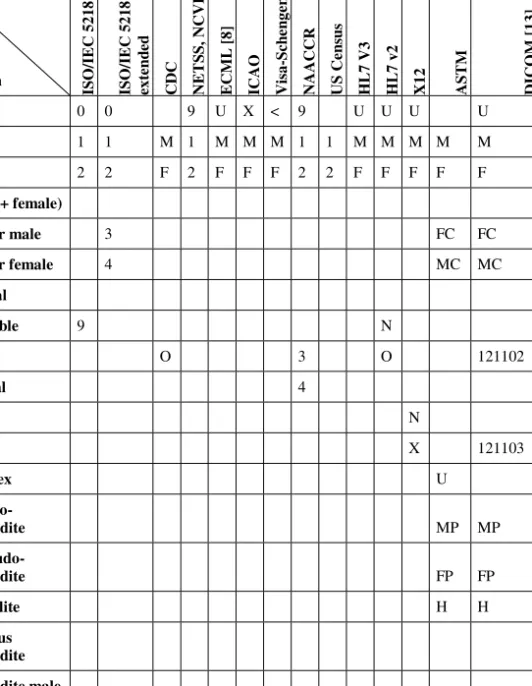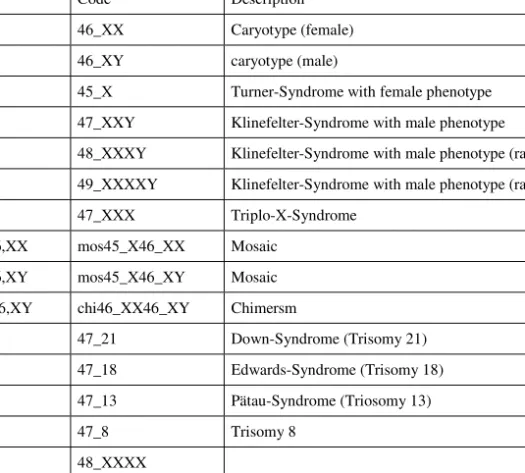How to Work with Vocabulary Correctly, Exemplified with Gender Coding?
Frank OEMIG
a,b,c,1, Bernd BLOBEL
c,dand Peter GEIBEL
ba
Deutsche Telekom Healthcare and Security Solutions GmbH, Mülheim, Germany
b
German Association of Health IT Vendors – bvitg e.V., Berlin ,Germany
c
eHealth Competence Center Bavaria, Deggendorf Institute of Technology, Germany
d
Medical Faculty, University of Regensburg, Germany
Abstract. Popular data exchange standards facilitate the use of vocabulary in different ways. Quite often, the usage is based on, and in favor of, simple implementations not considering reality. In most cases the vocabulary is assembled in form of simple code lists. Well-known bad practice is neither to define proper concept descriptions for the individual codes leaving their interpretation to the developer nor to identify the underlying vocabulary domain resulting in a mixture of something. This paper takes the gender use case and analyses the use of codes within some data exchange standards and makes recommendations for improvements in handling and managing code systems correctly.
Keywords. Interoperability; Vocabulary; Code ystem
1. Introduction
The new e-health law in Germany intends to improve semantic interoperability among healthcare information systems [1]. But reality demonstrates that each individual organization claims their right to specify data exchange standards on their own, thus not considering any interoperability requirements. This ignorance starts at the syntactic level, continues at the semantic level, and finally has no chance to ever reach service level. Data exchange specifications do not only touch those different levels, but also include vocabulary fundamentally. Quite common is the specification of “tables”
without further meta-data or versioning information and no management procedure in place [2].
This paper analyses common practice and suggests an alternative to this behavior exemplified with coding of gender aspects.
2. Methods
International data exchange standards (CDC, NETSS, NAACCR, USA Census, HL7 v2, HL7 V3, X12, ASTM, DICOM, OBIS, UBIF) are examined for their use of codes in a gender context. Table 1 provides an overview about standards and their
1 Corresponding Author: Frank Oemig, PhD; Deutsche Telekom Healthcare and Security Solutions GmbH, Germany; Email: frank.oemig@t-systems.com
s
© 2016 European Federation for Medical Informatics (EFMI) and IOS Press.
This article is published online with Open Access by IOS Press and distributed under the terms of the Creative Commons Attribution Non-Commercial License 4.0 (CC BY-NC 4.0).
doi:10.3233/978-1-61499-678-1-344
incorporation of certain concepts (covering human beings and animals). The only commonality for all of them is the support of “male” and “female”, all other concepts are diverging and orthogonal in their semantics. However, all standards intend to use a single code from its list.
Table 1. Gender Coding with International Data Exchange Standards Standard
Description
ISO/IEC 5218 [3] ISO/IEC 5218 extended CDC NETSS, NCVHS [6] ECML [8] ICAO Visa-Schengen NAACCR US Census HL7 V3 HL7 v2 X12 ASTM DICOM [13] OBIS [16] UBIF [17]
not known 0 0 9 U X < 9 U U U U U ?
Male 1 1 M 1 M M M 1 1 M M M M M M m
Female 2 2 F 2 F F F 2 2 F F F F F F f
both (male + female) B
transgender male 3 FC FC fc
transgender female 4 MC MC mc
Transitional T
not applicable 9 N
Other O 3 O 121102
Transsexual 4
non-sexed N
Unsexable X 121103 I i
unknown sex U
male pseudo-
hermaphrodite MP MP
female pseudo-
hermaphrodite FP FP
Hermaprodite H H H h
simultaneous
hermaphrodite sh
hermaphrodite male
phase hm
hermaphrodite
female phase hf
Ambiguous A A 121102 a
mixed sex x
3. Results
This short summary clearly indicates that some standards mix different kind of concepts into a single value set. Other standards also introduce the notion of time as can be seen with codes for a “transition” process.
Common practice is to use only a single code. Most – if not all – applications only allow for a single value to be stored with a patient. Normally, i.e. in 99.9% of the solutions, an individual is associated with a single gender that persists over the whole life. Hence, there is no possibility to capture and maintain specifics like transsexual or transgender aspects. This is a rare exception. In some jurisdictional environments – like in Germany - keeping track of this kind of information is even illegal. Nevertheless, an appropriate representation is necessary and a correct handling is an essential precondition to manage future and upcoming challenges in vocabulary usage.
Table 2.a and 2.b demonstrate that the administrative gender, which is, e.g., used in a hospital for assigning beds, is more or less identical to what a person or natal register will maintain. The only distinction is that a register allows for not stating an explicit gender. In Table 1 this is listed as “non-sexed”. Furthermore, it is worth mentioning, that administrative gender is used for simple administrative reasons within hospitals and has nothing to do with sexual orientation, so that a reduction should not introduce any problems beyond possible discrimination perception of the person in question.
Note that the term “gender” pertains to gender roles and gender identity, whereas
“sex” refers to the biological sex of a person, which comprises chromosomal, gonodal, genital and hormonal sex. It is common practice that in clinical studies no clear distinction is made between these concepts, potentially introducing a statistical bias since transsexual and intersexual persons are mixed with “biological” men in women.
Table 2. a) Administrative Gender, b) Person Register
a) Code Description b) Code Description
M Male = M Male
F Female = F Female
U unknown
X Undetermined
Tables 3.a, 3.b and 3.c address different clinical aspects. Transgender issues normally only require the distinction between transgender (no assignment/definition of a gender or sexual orientation) and non-transgender. In principle, a Boolean value would be sufficient then. But for non-transgender persons, a gender assignment may become necessary again. Therefore, a level is introduced indicating, that male and female are specializations of non-transgender persons.
Table 3. a) intersexual, b) transsexual, c) transgender
a) Code Description b) Code Description c) Code Level Description M Male M Identifies as a man T 1 transgender W Female F Identifies as a woman NT 1 Non-transgender
a) Code Description b) Code Description c) Code Level Description
IS intersexual U Unknown M 2 Male
F 2 female
Discussing necessary and appropriate codes usually ends up with introducing a new code for “other” not specifying the real underlying meaning because it is unknown.
With the introduction of specialized code systems, this behavior is misleading and not necessary any more.
For some clinical, medical and biological questions, the genetic gender becomes necessary. For such a purpose, Table 4 suggests values for an appropriate code system.
Table 4. Genetics
Concept Code Description
46,XX 46_XX Caryotype (female)
46,XY 46_XY caryotype (male)
45,X 45_X Turner-Syndrome with female phenotype 47,XXY 47_XXY Klinefelter-Syndrome with male phenotype 48,XXXY 48_XXXY Klinefelter-Syndrome with male phenotype (rare) 49,XXXXY 49_XXXXY Klinefelter-Syndrome with male phenotype (rare) 47,XXX 47_XXX Triplo-X-Syndrome
mos45,X/46,XX mos45_X46_XX Mosaic mos45,X/46,XY mos45_X46_XY Mosaic chi46,XX/46,XY chi46_XX46_XY Chimersm
47,21 47_21 Down-Syndrome (Trisomy 21) 47,18 47_18 Edwards-Syndrome (Trisomy 18) 47,13 47_13 Pätau-Syndrome (Triosomy 13)
47,8 47_8 Trisomy 8
48,XXXX 48_XXXX 49,XXXXX 49_XXXXX
47,XYY 47_XYY XYY-Syndrome 48,XXYY 48_XXYY Y-Polysomy 49,XYYYY 49_XYYYY Y-Polysomy
Table 4 clearly indicates the necessity for clean code systems with a solid description
of the concepts. Each table (2.a to 4) represents a code system with clearly defined
concepts. These code systems can be used in conjunction with each other.
4. Discussion and Conclusions
Instead of mixing unclear or not well-defined concepts into a single value set, multiple codes from clean code systems should be conveyed. Paired with timing aspects such a transmission allows for a complete and correct patient history, if jurisdictional, legal and data privacy aspects are neglected.
References
[1] Geibel P, Oemig F, Kassner A: „Fallstudie: Das Geschlecht in den Datensätzen der Health-IT“, in eHealthCom, Magazin für Health IT, vernetzte Medizintechnik und Telemedizin, 06/15, p.48 www.e- health-com.eu
[2] Oemig, Blobel: Practical Implications of Value Set Definitions: an Example. Proceedings of the 15th International HL7 Interoperability Conference, p 25-27. Prague: emina; 2015.
[3] ISO/IEC 5218:2004
(http://standards.iso.org/ittf/PubliclyAvailableStandards/c036266_ISO_IEC_5218_2004(E_F).zip) [4] Canada National Body: ISO/IEC JTC1 SC36 N0834 - Business Case and for Rationale
[5] Incorporating “Multilingual Capability and Equivalency as one of the Basic Principles, at the Architectural and Structural Levels, for the Development of the Multipart MLR standard”.
(http://old.jtc1sc36.org/doc/36N0834.pdf) old.jtc1sc36.org, 19. August 2004, S. 6, Fußnote 2
[6] UK Government Data Standards:- Person Gender at Registration (http://www.datadictionary.nhs.uk/version2/data_dictionary/data_field_notes/p/person_gender_at_regis tration_de.asp?shownav=0), Feb.15th 2016
[7] Standards and Liaison Committee Health Information and Surveillance Systems Board: Common Data Elements Implementation Guide Version 2.4 (http://www.cdc.gov/DATA/impv24.pdf) (PDF; 338 kB), U.S. Department of Health and Human Services, 3. Januar 2000, S. 35 ff.; Proposed CDC Health Data Standards (http://www.cdc.gov/DATA/INDEX.HTM), Website des Centers for Disease Control and Prevention
[8] RFC 4112: Electronic Commerce Modeling Language (ECML) - Version 2 Specification. Juni 2005, Motorola Laboratories
[9] Multilateral Interoperability Program, NATO (Hrsg.): The Joint C3 Information Exchange Data Model (JC3IEDM Main) (http://www.mip-site.org/publicsite/04- Baseline_3.0/JC3IEDMJoint_C3_Information_Exchange_Data_Model/JC3IEDM-Main-GBRDMWG- Edition_3.1b_2007-12-13.pdf) (PDF) Edition 3.1b, 13. Dezember 2007, mip-site.org
[10] Julie Butler: X Marks the Spot for Intersex Alex.
(http://www.sageaustralia.org/docs/West%20Australian%20Newspaper.pdf) In: The Western Australian, Perth, 11. January 2003; HTML (http://www.tgcrossroads.org/news/?aid=597)
[11] Human Rights Commission (Hrsg.): To Be Who I Am - Report of the Inquiry into Discrimination Experienced by Transgender People (http://www.hrc.co.nz/hrc_new/hrc/cms/files/documents/06-May- 2008_10-35-46_Trans_Gender_Inquiry_Report_Final_Word_May_08.doc) (MS Word; 1,6 MB), Januar 2008, New Zealand, ISBN 978-0-478-28643-4
[12] Gemeinsame konsularische Instruktion an die diplomatischen Missionen und die konsularischen Vertretungen, die von Berufskonsularbeamten geleitet werden (http://eur- lex.europa.eu/LexUriServ/LexUriServ.do?uri=CELEX:52005XG1222(01):DE:NOT), 22. Dezember 2005, eur-lex.europa.eu
[13] National Electrical Manufacturers Association (Hrsg.): PS 3.3-2007 - DICOM Part 3: Information Object Definitions (http://medical.nema.org/dicom/2007/07_03pu.pdf ) (PDF; 4,5 MB ) medical.nema.org, 2007, Version: 28. Dezember 2006
[14] ISIS & CGI Information Systems and Management Consultants Inc. (Deepali Thussu): ZIMS - PM224
[15] Animal Management - Version 2.00 (http://zims.isis.org/System%20Use%20Cases%20%20PDF/PM224%20-%20Page%20Dictionary%20-
%20Animal%20Management%20v2.0.pdf) (Login required), 5. Oktober 2006
[16] The OBIS SchemaVersion 1.1, http://www.iobis.org/tech/provider/schemadef1/, 14. 8. Juli 2005
[17] TDWG-SDD: TWiki - SDD Web - Version101 - Version1dot1, http://wiki.tdwg.org/twiki/bin/view/SDD/Version1dot1, SDD1.1.zip accessed March 19. 2007, there SDD1.1/documentation/UBIF_EnumData.html


